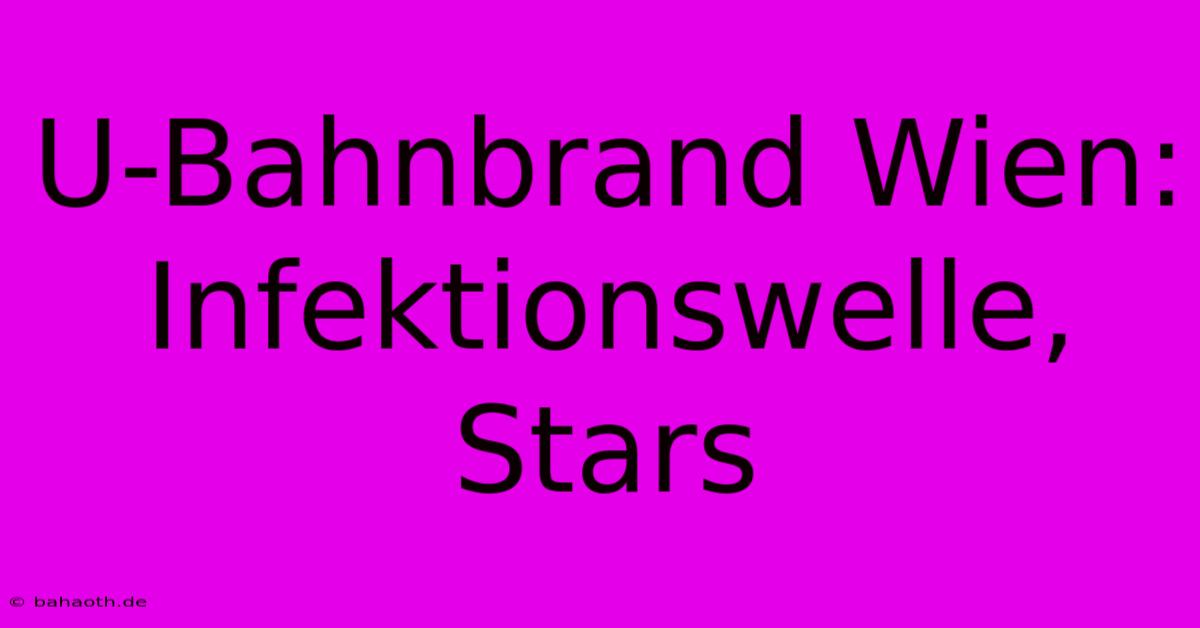U-Bahnbrand Wien: Infektionswelle, Stars

Discover more detailed and exciting information on our website. Click the link below to start your adventure: Visit Best Website U-Bahnbrand Wien: Infektionswelle, Stars. Don't miss out!
Table of Contents
U-Bahnbrand Wien: Infektionswelle, Stars – A City's Trauma and its Aftermath
Okay, so, the Vienna U-Bahn fire – man, what a mess that was. I remember seeing the news reports; the whole thing was crazy. Total chaos, right? People freaking out, smoke everywhere… the images were intense. It wasn't just the fire itself, though. The aftermath? That's where things got really interesting, and kinda messed up.
The Initial Panic and the Spread of Misinformation
First off, the initial panic was understandable. People were trapped underground, you know? Total claustrophobia situation. Then, the rumors started flying faster than you could say "Feuerwehr!" Social media went wild with speculation. Some people were saying it was a terrorist attack – which, obviously, turned out to be completely false. Others were talking about a massive electrical failure, a gas leak… It was total information overload, and a lot of it was just plain wrong. This really highlights the importance of reliable news sources during a crisis. Stick to reputable outlets, folks – don't just believe anything you see on some random Facebook group.
This whole situation reminds me of something that happened to me during a completely unrelated incident. I was covering a local festival a few years ago, and a rumor spread like wildfire that there was a dangerous animal on the loose. It turned out to be a ferret. A ferret! People were running scared, businesses were closing… all because of a little ferret. The point is: misinformation can spread like, bam, wildfire. Always verify information before sharing it, especially during emergencies.
The Infection Wave: A Secondary Disaster?
But here's the thing that really got me thinking – the subsequent infection wave. With so many people crammed together in emergency shelters, the risk of spreading illnesses was, well, huge. Think about it: stress, exhaustion, close proximity… the perfect breeding ground for all sorts of bugs. It wasn't a direct result of the fire, sure, but it was a completely foreseeable consequence of the chaos. This wasn't just about the immediate impact of the fire; it was about the long-term effects of a crisis and the ripple effects through the community.
This is where good crisis management comes in, you know? Authorities needed to be prepared for this kind of thing – having proper emergency shelters, adequate medical support, and a clear communication strategy to prevent the spread of misinformation and disease. It's easy to focus on the immediate event, but the long-term consequences often end up being far more significant. It really brought home the importance of thinking about the bigger picture.
Celebrity Involvement and Public Response
Then, there were the celebrities. Several Austrian stars got involved in relief efforts, donating money, visiting shelters, that kind of thing. It was heartwarming to see them step up. However, this also brought about a whole other level of media attention. While positive in terms of generating funds and raising awareness, it also highlighted how a crisis can quickly become a media circus. This is an interesting point to consider the impact of public figures and how they play a role in shaping public opinion and the efficacy of disaster response. It wasn't always well-managed, and sometimes it felt distracting.
To improve crisis response, we need better coordination between different agencies, clearer communication channels, and a more resilient infrastructure. The Vienna U-Bahn fire, and it's aftermath, serves as a brutal reminder of how quickly things can go wrong and the importance of being prepared for the unexpected. It's about more than just putting out fires; it's about managing the entire chain of events – before, during, and after. And yeah, maybe keeping a few extra ferrets away from public events too. Just saying.

Thank you for visiting our website wich cover about U-Bahnbrand Wien: Infektionswelle, Stars. We hope the information provided has been useful to you. Feel free to contact us if you have any questions or need further assistance. See you next time and dont miss to bookmark.
Featured Posts
-
Zweifel An Der K Frage Wachsen Etwas Allgemeiner Aber Passt
Nov 20, 2024
-
Drogenvorwuerfe Allanahs Tochter Im Fokus
Nov 20, 2024
-
Historischer Aufstieg San Marino In Nations League
Nov 20, 2024
-
Winterpersonal Finden Strategien And Wege
Nov 20, 2024
-
Neue Lindt Schokolade Dubai Edition In At
Nov 20, 2024
